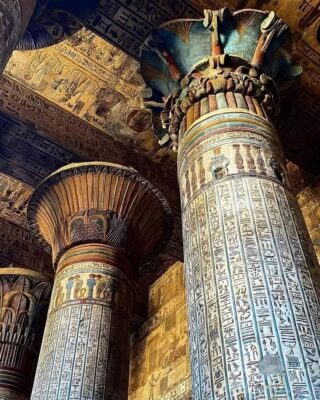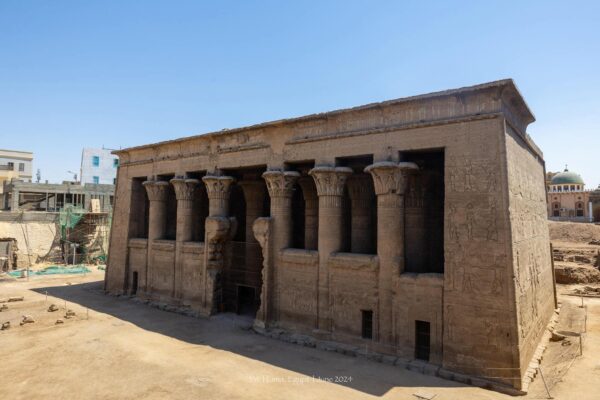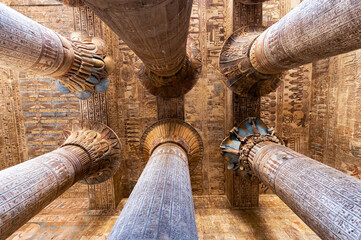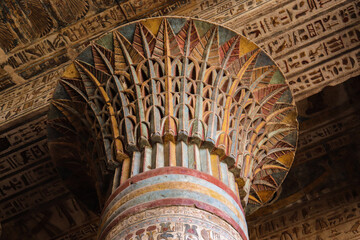The Temple of Esna, located in the modern-day city of Esna, Egypt, is one of the most important and well-preserved examples of ancient Egyptian temple architecture. This magnificent structure, dedicated to the god Khnum, is renowned for its intricate carvings, unique layout, and historical significance. Here’s an in-depth look at the Temple of Esna and its architectural and cultural importance.
Follow archeology.dulichvn.net to learn more about mysterious artifacts.

The History of the Temple of Esna
A Glimpse Into Ancient Egyptian Religion
The Temple of Esna, a masterpiece of ancient architecture, originated during the Ptolemaic period under the reign of Ptolemy VI (180–145 BCE). Though its foundation reflects the Ptolemaic era, subsequent enhancements were heavily influenced by Roman contributions. This temple was dedicated to Khnum, the revered ram-headed god of creation and fertility, who was believed to govern the life-giving waters of the Nile. For ancient Egyptians, Khnum held the power to shape their destiny, blessing the land with fertility and ensuring bountiful harvests. The temple served as a sacred space where people sought his divine favor, uniting spirituality with the pragmatic need for agricultural prosperity.
Influence of the Ptolemaic and Roman Periods
The Temple of Esna embodies a fascinating fusion of Egyptian and Roman cultures. While its foundation was laid during the Ptolemaic dynasty, the Roman Empire left a lasting imprint through architectural refinements and artistic embellishments. The temple’s walls are adorned with detailed reliefs and inscriptions, showcasing deities, rituals, and offerings that provide insight into both religious practices and imperial influence.
These carvings are a testament to Egypt’s enduring traditions interwoven with Roman aesthetic sensibilities. Columns featuring floral capitals, motifs of Greek origin, and hieroglyphic texts exemplify this blend. The incorporation of Roman elements alongside Egyptian symbolism reflects not only the continuity of faith but also the adaptation to shifting political powers.
Temple of Esna’s Role in Egyptian Society
In the vibrant life of ancient Egypt, the Temple of Esna stood as more than a religious monument—it was a cornerstone of societal and cultural cohesion. The temple hosted elaborate rituals and ceremonies, particularly during the annual flooding of the Nile, a vital natural event that ensured the fertility of the soil and sustained Egypt’s agricultural economy. These ceremonies were both spiritual acts of gratitude and prayers for continued prosperity.
The temple also symbolized the harmony between religious authority and political power. Priests and rulers alike participated in the offerings and rituals, reinforcing their divine mandate to lead and protect the people. As a communal gathering point, the Temple of Esna nurtured a shared cultural identity, fostering connections between individuals and their spiritual heritage while affirming the unity of the state.

Architectural Features of the Temple of Esna
The Stunning Hypostyle Hall
The hypostyle hall of the Temple of Esna stands as a breathtaking architectural and artistic achievement. This expansive hall, supported by 24 towering columns, creates a majestic space that exudes both grandeur and spiritual reverence. Each column is intricately adorned with hieroglyphic inscriptions and mythological depictions, celebrating the temple’s dedication to the gods. These carvings illustrate scenes of pharaohs making offerings to Khnum and other deities, symbolizing the divine connection between rulers and the spiritual realm.
Beyond their structural purpose, the columns serve as monumental expressions of ancient Egyptian religious beliefs. Their artistic detail captures not only the skill of ancient craftsmen but also the profound symbolism that pervaded every aspect of Egyptian temple design.
Unique Ceiling Reliefs
The ceiling of the hypostyle hall is an unparalleled wonder, featuring exquisite astrological reliefs. Among these is the depiction of the sky goddess Nut, shown arching across the heavens, symbolizing the protective canopy of the universe. Accompanying Nut are carvings of celestial bodies, such as stars, planets, and the sun, reflecting the Egyptians’ advanced understanding of astronomy.
These ceiling reliefs embody the Egyptians’ belief in the cosmic harmony between earth and the divine. They represent a metaphysical link, showing that the temple was not merely a physical structure but also a sacred space connecting mortals with the celestial and spiritual realms.
The Inscriptions and Carvings
The temple’s walls are a visual and textual chronicle of Egyptian mythology and religious life. Intricately carved scenes depict pharaohs offering gifts to Khnum, often accompanied by other gods, in acts of devotion that reaffirm the sacred bond between humans and the divine.
Inscriptions on the walls are rendered in both hieroglyphs and demotic script, highlighting the evolution of Egyptian writing during the Ptolemaic period. These texts are not just decorative; they hold immense historical significance, offering insights into the ritual practices, cultural transitions, and philosophical beliefs of the time. The blend of text and imagery transforms the temple into a living record of ancient Egyptian civilization, immortalizing its myths, rulers, and enduring spirituality.

See more: Ecuadorian Amazon: Unveiling a Pre-Columbian Metropolis
The Significance of the Temple of Esna
A Testament to Ancient Egyptian Culture
The Temple of Esna stands as a magnificent testament to the religious, cultural, and artistic heritage of ancient Egypt. Its intricate architecture, detailed carvings, and extensive inscriptions offer profound insights into the beliefs, rituals, and daily life of its time. Every element of the temple reflects the Egyptians’ deep reverence for their gods and their unparalleled ability to integrate spiritual devotion with architectural mastery.
The temple not only represents a sacred space for worship but also showcases the innovative engineering techniques of ancient craftsmen. It exemplifies how the Egyptians blended form and function, using art and architecture as a means to convey their cosmological and religious ideologies.
Preservation and Modern-Day Importance
Despite enduring the passage of millennia, the Temple of Esna remains remarkably well-preserved, serving as a window into the world of ancient Egypt. Its ornate carvings and inscriptions, though weathered, retain their intricate beauty, continuing to captivate historians and archaeologists who seek to uncover the mysteries of the past. These features provide crucial information about the religious ceremonies, governance, and artistic traditions of the Ptolemaic and Roman eras.
Preservation efforts are ongoing to combat the effects of natural erosion, human activity, and environmental factors. Modern conservation techniques, including cleaning and structural reinforcement, aim to safeguard the temple for future generations. Such efforts underline its importance as both a historical treasure and a vital resource for understanding Egypt’s rich and diverse history.
A Cultural and Tourist Hub
Today, the Temple of Esna has become a prominent cultural and tourist destination, attracting visitors from around the globe. Tourists marvel at the temple’s colossal hypostyle hall, elaborate reliefs, and astrological ceiling decorations, which provide a firsthand experience of ancient Egyptian grandeur.
Beyond its architectural allure, the temple’s unique combination of Ptolemaic and Roman influences makes it a compelling site for those interested in cultural fusion. Its significance transcends tourism, serving as a symbol of Egypt’s enduring legacy and a reminder of the innovation and spirituality that defined its ancient civilization.
As visitors walk through its columns and study its carvings, they not only engage with history but also help sustain the temple’s relevance in the modern world, ensuring that its legacy continues to inspire awe and admiration.

Conclusion: The Enduring Legacy of the Temple of Esna
The Temple of Esna stands as a monumental example of ancient Egyptian religious and architectural achievement. From its grand hypostyle hall to the intricate ceiling carvings, every element of the temple reflects the profound spiritual and artistic legacy of ancient Egypt. As a site of religious devotion, cultural significance, and architectural splendor, it continues to captivate visitors, providing a glimpse into the ancient world and the lasting influence of Egypt’s great civilization.


CÁC TIN KHÁC
Mary Walton: The Forgotten Inventor Who Helped Clean Up America’s Cities
Tomb of Queen Nefertari in the Valley of the Queens, Egypt
Discover the Hypostyle Hall of the Temple of Hathor at Dendera
Venus de Losange: Unveiling the Mystery of a 20,000-Year-Old Paleolithic Icon